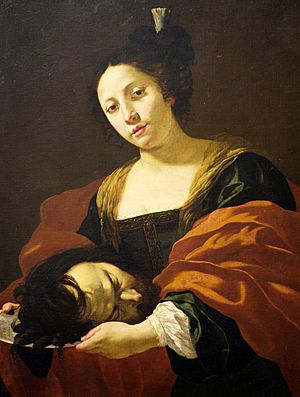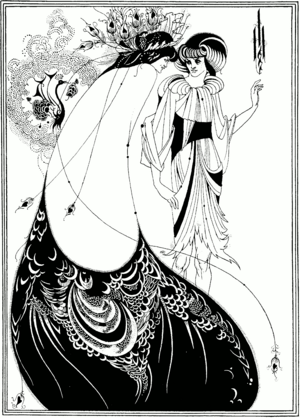Salome facts for kids
Salome (pronounced sah-LOH-mee) was a Jewish princess from a powerful family. She was the daughter of Herod II and Princess Herodias, and the stepdaughter of Herod Antipas. Her story is found in the New Testament (parts of the Christian Bible) and in writings by a historian named Flavius Josephus.
In the New Testament, Salome is not named, but she is known as the stepdaughter of Herod Antipas. The Bible says she asked for and received the head of John the Baptist. Josephus, on the other hand, gives her name as Salome. He also tells us that she married her uncle, Philip the Tetrarch, and later her cousin, Aristobulus of Chalcis. This made her a queen in areas called Chalcis and Armenia Minor.
The story of Salome's dance at her stepfather's birthday party, where she asked for John the Baptist's head, has inspired many artists. Her story appears in paintings, books, and music. Famous artists like Titian and Gustave Moreau have painted her. Oscar Wilde wrote a play about her in 1891, and Richard Strauss turned it into an opera in 1905. Salome has also been a character in movies, like the 1953 film starring Rita Hayworth.
First-Century Accounts of Salome
People often connect Salome with the daughter of Herodias mentioned in the Gospel of Mark and the Gospel of Matthew. These are two books in the New Testament. She is said to have danced for Herod Antipas. The historian Josephus also wrote about a daughter of Herodias named Salome, mentioning her marriages and children.
Salome in the New Testament
According to the Gospel of Mark, Herodias was angry with John the Baptist. He had said that Herod's marriage to her was against the law. Herodias's daughter danced for Herod at his birthday party. Herod was so pleased that he promised her anything she wanted. After talking to her mother, the girl asked for the head of John the Baptist.
Some old Greek versions of the Gospel of Mark suggest that both the mother and daughter might have been named Herodias. However, in many translations, she is simply called "Herodias's daughter" or "the girl." Because the Bible does not name her, the idea that she was also called Herodias became popular in Europe a long time ago.
Salome in Josephus's Writings
The ancient historian Flavius Josephus wrote about Salome in his book Jewish Antiquities. He named her as the daughter of Herodias and Herod II. Josephus also wrote about her marriages. He said she first married Philip the Tetrarch, who was her uncle. After Philip died, she married her cousin, Aristobulus of Chalcis.
Ancient Coins Featuring Salome
A few old coins have been found that show pictures of Aristobulus and Salome. These coins help historians learn more about them.
Salome's Influence in Art and Culture
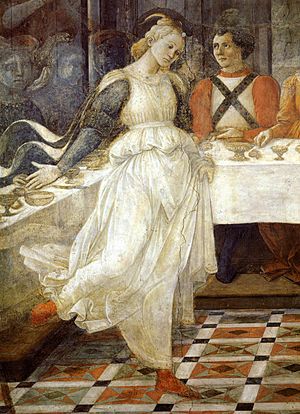

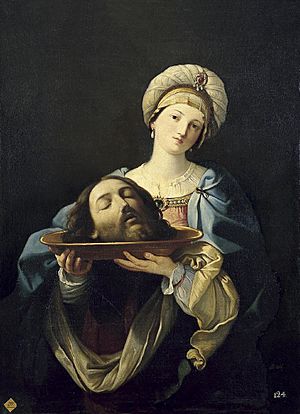
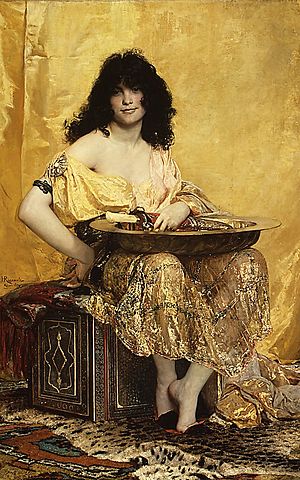

The story of Salome's dance and her request for John the Baptist's head has been very popular in art. For a long time, Christian artists in the Middle Ages showed her as a dangerous woman who tempted men away from good.
She wasn't always called Salome in art and stories until the 1800s. That's when writer Gustave Flaubert used the name "Salome" in his short story "Herodias," following Josephus's account.
Paintings and Sculptures of Salome
Many famous painters have created works about Salome. Some of these artists include Masolino da Panicale, Filippo Lippi, Titian, Caravaggio, Gustave Moreau, and Lovis Corinth. Their paintings often show her with the head of John the Baptist.
Salome in Theatre and Books
In 1877, Gustave Flaubert published his "Three Tales," which included "Herodias." In this story, Salome's mother, Herodias, and priests who feared John's religious power are mainly blamed for his death. Salome herself is shown as a young girl who even forgets the name of the man whose head she asked for.
Playwright Doric Wilson created a modern version of the Salome story called Now She Dances! in 1961. The National Theatre also produced a play called Salome, which was very popular.
Oscar Wilde's Play About Salome
Oscar Wilde wrote a famous play about Salome. It was first banned in London in 1892 because it showed biblical figures on stage, which was not allowed then. The play later opened in Paris in 1896. In Wilde's play, Salome becomes strangely obsessed with John the Baptist. When he rejects her, she has him executed.
Operas Based on Wilde's Play
Oscar Wilde's play was turned into a one-act opera by Richard Strauss. This opera, also called Salome, first opened in 1905. It is famous for a scene called the "Dance of the Seven Veils." Like Wilde's play, the opera focuses on Salome herself, making her mother a smaller character.
Another opera based on Wilde's play was created by Antoine Mariotte. It premiered in 1908.
Ballets Inspired by Salome
The story of Salome has also been told through ballet. In 1907, Florent Schmitt composed a ballet called La tragédie de Salomé. Another Salome ballet was created by Japanese composer Akira Ifukube in 1948. Danish choreographer Flemming Flindt's ballet Salome premiered in 1978.
Poetry About Salome
Many poets have written about Salome. Some of these poets include Ai (1986), Nick Cave (1988), and Carol Ann Duffy (1999).
Other Music About Salome
A piano piece called Salomé (1909) was composed by Mel Bonis. It is part of her series called Femmes de Légende (Women of Legend).
Archibald Joyce composed three waltzes about Salome: Vision of Salome (1909), Passing of Salome (1912), and Phantom of Salome (1945).
Many songs have also been written about Salome by various artists, including U2 (1990), Andrew Lloyd Webber (1993), Liz Phair (1993), and Chayanne (1999).
Salome in Film
Wilde's play Salome has been made into several films. A famous silent film version, Salome, was released in 1923. There was also a 1988 film called Salome's Last Dance.
In the 1950 movie Sunset Boulevard, a character named Norma Desmond writes a screenplay for a silent film about Salome.
Other films about Salome include:
- Salomé (1918), starring Theda Bara.
- Salomé (1953), starring Rita Hayworth.
- Salomé (1972), starring Carmelo Bene.
- Salome (1986), a French-Italian movie.
- Salomé (2002), directed by Carlos Saura, featuring flamenco dance.
- Wilde Salome (2011), a film by Al Pacino, with Jessica Chastain as Salome.
See also
 In Spanish: Salomé (princesa) para niños
In Spanish: Salomé (princesa) para niños
- List of biblical figures identified in extra-biblical sources
- List of names for the biblical nameless


